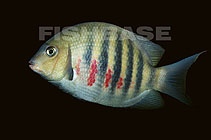| Family: |
Cichlidae (Cichlids), subfamily: Etroplinae |
| Max. size: |
12.97 cm SL (male/unsexed) |
| Environment: |
demersal; freshwater, |
| Distribution: |
Africa: northwestern Madagascar (Ref. 78623). |
| Diagnosis: |
Dorsal spines (total): 15-16; Dorsal soft rays (total): 20-23; Anal spines: 8-9; Anal soft rays: 14-16. Diagnosis: Paretroplus maromandia is a member of the deep-bodied clade of Paretroplus and the only member of the genus, apart from P. polyactis, in which the entire lateral series of bars is prominent, including in adults; it is the only species of Paretroplus occurring in western drainages with strong lateral barring (Ref. 78623). Paretroplus maromandia is distinguished from P. polyactis by the presence of lateral bars that extend more or less over the entire flank, from the dorsal-fin base, and sometimes extending onto the fin membrane itself, to the anal-fin base, vs. bars that terminate approximately under the lateral midline and do not extend to the anal-fin base in P. polyactis; by a greater lateral-line scale count, 39-41 vs. 31-36; fewer gill rakers on the lower limb of the first arch, 10 vs. 11-13; a higher dorsal-fin ray count, 20-23 vs. 15-18; and by bright yellow to greenish-yellow body ground colouration interrupted by seven prominent, solid black vertical bars on the flanks, vs. bars and intervening regions highly speckled/spotted and resembling a chain-link fence, owing to pigmentation pattern in which scale margins are markedly darker than centers in P. polyactis (Ref. 78623). In life, P. maromandia is further distinguished from P. polyactis by a golden iris, vs. red, and the presence of vivid red pigmentation on the flanks, below the lateral midline (Ref. 78623). |
| Biology: |
|
| IUCN Red List Status: |
Endangered (EN); Date assessed: 02 July 2016 (B1ab(i,ii,iii,iv)) Ref. (130435)
|
| Threat to humans: |
harmless |
Source and more info: www.fishbase.org. For personal, classroom, and other internal use only. Not for publication.

